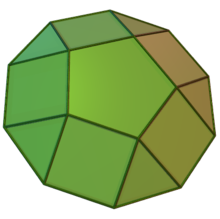This article needs additional citations for verification. (March 2024) |
| Set of cupolae | |
|---|---|
 Pentagonal example | |
| Faces | n triangles, n squares, 1 n-gon, 1 2n-gon |
| Edges | 5n |
| Vertices | 3n |
| Schläfli symbol | {n} || t{n} |
| Symmetry group | Cnv, [1,n], (*nn), order 2n |
| Rotation group | Cn, [1,n]+, (nn), order n |
| Dual polyhedron | ? |
| Properties | convex, prismatoid |
In geometry, a cupola is a solid formed by joining two polygons, one (the base) with twice as many edges as the other, by an alternating band of isosceles triangles and rectangles. If the triangles are equilateral and the rectangles are squares, while the base and its opposite face are regular polygons, the triangular, square, and pentagonal cupolae all count among the Johnson solids, and can be formed by taking sections of the cuboctahedron, rhombicuboctahedron, and rhombicosidodecahedron, respectively.
A cupola can be seen as a prism where one of the polygons has been collapsed in half by merging alternate vertices.
A cupola can be given an extended Schläfli symbol {n} || t{n}, representing a regular polygon {n} joined by a parallel of its truncation, t{n} or {2n}.
Cupolae are a subclass of the prismatoids.
Its dual contains a shape that is sort of a weld between half of an n-sided trapezohedron and a 2n-sided pyramid.